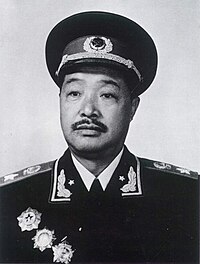He Long
| He Long | |
|---|---|
| 贺龙 | |

Marshal He Long in 1955.
|
|
| Member of Central Committee of the Communist Party of China | |
|
In office October 1954 – 9 June 1969 |
|
| Chairman | Mao Zedong |
| 1st First Vice Premier of the People's Republic of China | |
|
In office October 1954 – 9 June 1969 |
|
| Premier | Zhou Enlai |
| Succeeded by | Lin Biao |
| Personal details | |
| Born |
22 March 1896 Sangzhi, Hunan |
| Died | 9 June 1969 (aged 73) Beijing |
| Political party | Communist Party of China |
| Awards |
|
| Military service | |
| Allegiance |
|
| Service/branch |
|
| Years of service | 1914–69 |
| Rank | Marshal of People's Republic of China |
| Commands | Division Commander of the Eighth Route Army, Vice Chairman of Central Military Commission |
| Battles/wars | Northern Expedition, Long March, Hundred Regiments Offensive, Chinese Civil War |
He Long (simplified Chinese: 贺龙; traditional Chinese: 賀龍; pinyin: Hè Lóng; Wade–Giles: Ho Lung; March 22, 1896 – June 8, 1969) was a Chinese military leader. He was from a poor rural family of a minority ethnic group in Hunan, and his family was not able to provide him with any formal education. He began his revolutionary career after avenging the death of his uncle, when he fled to become an outlaw and attracted a small personal army around him. Later his forces joined the Kuomintang, and he participated in the Northern Expedition.
He rebelled against the Kuomintang after Chiang Kai-shek began violently suppressing Communists, when he planned and led the unsuccessful Nanchang Uprising. After escaping, he organized a soviet in rural Hunan (and later Guizhou), but was forced to abandon his bases when pressured by Chiang's Encirclement Campaigns. He joined the Long March in 1935, over a year after forces associated with Mao Zedong and Zhu De were forced to do so. He met with forces led by Zhang Guotao, but he disagreed with Zhang about the strategy of the Red Army and led his forces to join and support Mao.
After settling and establishing a headquarters in Shaanxi, He led guerrilla forces in Northwest China in both the Chinese Civil War and the Second Sino-Japanese War, and was generally successful in expanding areas of Communist control. He commanded a force of 170,000 troops forces by the end of 1945, when his force was placed under the command of Peng Dehuai and He became Peng's second-in-command. He was placed in control of Southwest China in the late 1940s, and spent most of the 1950s in the Southwest administering the region in both civilian and military roles.
...
Wikipedia
